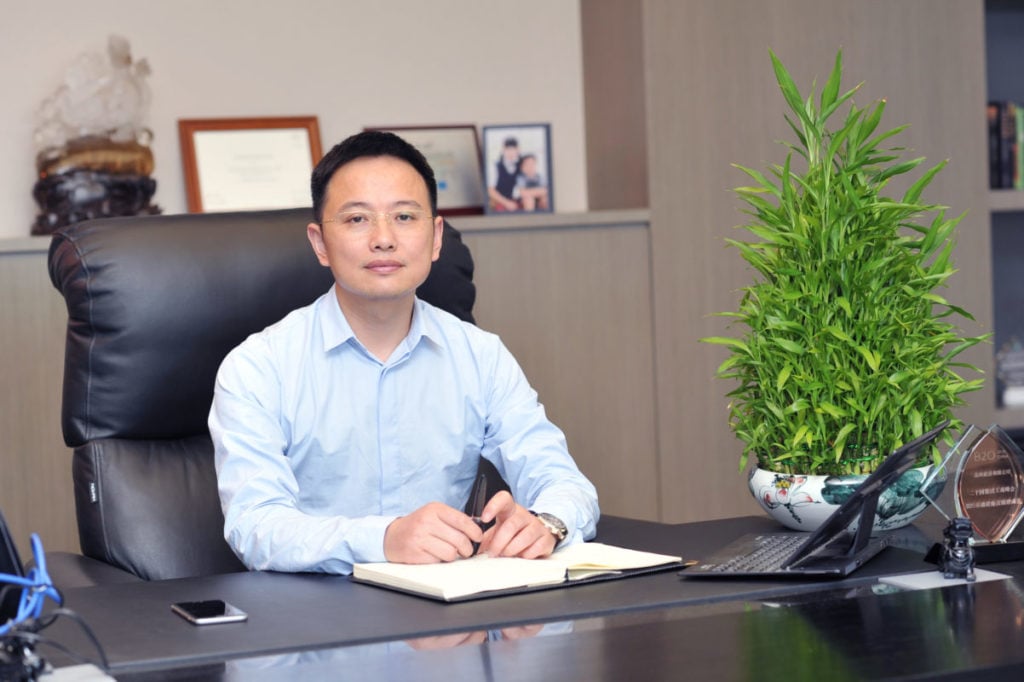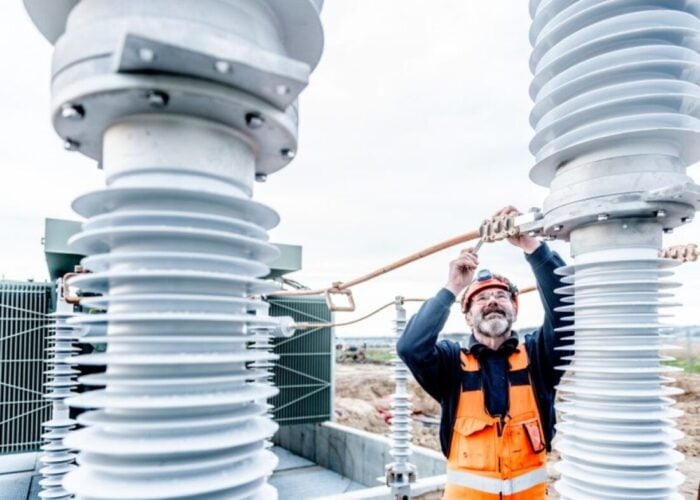
Having reclaimed the top spot for global module shipments for 2023 after a hiatus of three years, JinkoSolar could be forgiven for enjoying a period of satisfied reflection at a job well done, yet the company considers the achievement not as the end, but rather the start of a renewed era of competition, especially given the current market scenario.
Company chairman David Lee explains: “Since the start of last year, we’ve seen incredibly fierce competition in our industry. I’m really proud of what our team has managed to achieve in such a competitive environment, which truly showcases the strong execution capabilities of the Jinko team.
Unlock unlimited access for 12 whole months of distinctive global analysis
Photovoltaics International is now included.
- Regular insight and analysis of the industry’s biggest developments
- In-depth interviews with the industry’s leading figures
- Unlimited digital access to the PV Tech Power journal catalogue
- Unlimited digital access to the Photovoltaics International journal catalogue
- Access to more than 1,000 technical papers
- Discounts on Solar Media’s portfolio of events, in-person and virtual
“Our company’s position in the industry today isn’t the result of getting just one thing right. In 2021, when faced with formidable competition in the market, we took a step back to reassess our strategic direction. To this day, that strategy remains crystal clear.
“First, we must relentlessly push for technological advancements and innovation to enhance the competitiveness of our products. Second, our global operations need to be strengthened to improve our worldwide service capabilities. Third, efficient management and systematic development are crucial to enhance our operational competitiveness. We have followed this strategy with absolute determination over these three years,” Lee says.
A shifting market
During the course of these three years, the PV industry’s landscape has dramatically transformed, with seismic shifts in both market and technology. While passivated emitter and rear cell (PERC) technology dominated the industry in 2021, by 2023 n-type had made significant strides, the introduction of hundreds of gigawatts of tunnel oxide passivated contact (TOPCon) capacity signifying an effective phasing out of extensive existing PERC capacities.
Lee continues: “Looking ahead, we’re likely to face an overcapacity issue within the industry, and the phasing out of certain capacities may occur more swiftly than anticipated. There are three specific types of capacity which will quickly become obsolete. Firstly, I foresee that capacities that were unprofitable in 2023 will not be sustainable; secondly, capacities lacking market presence and the ability to sustain continuous operation will also be quickly eliminated. Lastly, those capacities without the potential for ongoing investment will also be phased out, as continuous efficiency improvements are essential in the photovoltaic field.”
At present, the industry is witnessing a rapid decline in p-type capacities, with reports suggesting that over 140GW of PERC cell capacity has been decommissioned and an additional 60GW transitioning to n-type. Of all the n-type capacity currently financed, less than half is actually operational and in mass production, and, given the rapid growth in market demand, advanced n-type capacity stands to gain significant developmental opportunities over its outdated alternatives.
Recently, as several state-owned organisations in China have begun their bulk procurement of solar modules, the latest prices have been seen fluctuating around RMB0.8 per watt (US$0.11). This, coupled with less-than-expected performance from several manufacturers in the last quarter, has added a degree of chill to the industry this winter.
“These are challenging times,” Lee admits, pointing out that some companies might be operating below their full potential, possibly facing challenges to their future operations. “Additionally, the first quarter is usually a slow period for the market. I’m expecting demand in the first quarter of 2024 to be lower than in the last quarter of 2023. With prices dropping, there’s likely going to be a bit of panic in the air.”
The potential for recovery
That said, Lee believes that the worst will pass and recovery will follow. “I’m quite bullish about market demand in 2024. I foresee a 20% growth compared to 2023, primarily driven by the falling prices which boost the return on investment for solar projects.
“I’ve always said we shouldn’t overemphasise short-term disturbances while underestimating long-term trends. This is particularly true for our industry at this moment. It’s crucial to stay confident during downturns because, with costs coming down, solar energy is undoubtedly the future,” Lee says.
Lee’s confidence is further bolstered by his faith in his own company’s strengths.
“First off, I think top-tier companies hold substantial advantages, thanks to their solid customer base, technological prowess and financial resources. Jinko is clearly ahead of the pack in the industry, a testament to our strong market presence and the competitiveness of our products.
“Moreover, it’s standard practice for us to lock in over 50% of our orders by the end of each year, which we have once again achieved for 2024, ensuring that we have a full production schedule for the entire year. Naturally, there will be some market shifts and occasional price tweaks along the way, given that each market and client contract is unique, but this level of advanced order volume robustly underpins our operations for the coming year.”
“Global layout, localised marketing”
The PV sector has increasingly witnessed a trend whereby the leading companies are pulling further ahead of the rest. According to early reports from PV Tech, the top four global module manufacturers in 2023 accounted for more than 55% of total shipments, with the top seven companies capturing over 70% of the market share. This trend is likely to continue in 2024, as the industry undergoes significant adjustments.
So, despite the considerable challenges facing the industry at present, based on 2023’s figures, Lee anticipates significant growth in Jinko shipments in 2024, continuing: “Whether it’s product innovation, market reach, or the efficiency of our production capacity, Jinko has excelled in all areas. By the end of the year, we aim for our TOPCon technology to achieve an efficiency of 26.5%, with all our modules reaching a power output of over 600 watts. We’re confident in our ability to thrive through this new cycle, bolstering our standing in the industry and expanding our market share.”
Jinko holds an enviable market share in key global markets, including Europe, the Middle East, Australia and India. This ongoing success is largely due to its well-established global strategy, encapsulated by the mantra of “global layout, localised marketing”, which enables the company to stay in tune with local markets, allowing for more effective customer service.
Looking ahead to the rest of 2024, Jinko has plans to reinforce its market presence in areas including the US and the Middle East. “The US presented specific challenges for us in 2022 and 2023, but we’re optimistic about 2024, largely thanks to our smooth entry into the market. We are the only Chinese company to have successfully navigated the US anti-circumvention inquiries, setting us apart in the industry,” Lee explains.
Global challenges
In the process of taking its products global, Jinko has been faced with a series of trade barriers and regulations introduced by different countries and regions, including the US, India and the European Union. To overcome these challenges, the company proactively began to construct manufacturing facilities overseas and today has 12GW of vertically integrated international capacity, giving it the most significant overseas manufacturing footprint of any Chinese company.
In discussing the minutiae involved in setting up manufacturing overseas, Lee points out several key factors that need consideration: geopolitical dynamics, industrial infrastructure, competitive landscape within the supply chain, currency fluctuations, policy shifts and the credibility of related governments. Clearly, it’s also crucial to evaluate whether locally produced products can maintain their competitiveness.
PV Tech has reported that, in addition to existing barriers, Europe is looking to draft a new set of regulations, similar to those in force in the US. Over the past year, the term ESG (environmental, social and governance) has become a recurring theme in proposals from several European bodies, with SolarPower Europe releasing a ‘Solar Sustainability Best Practice Benchmarks’ report, surveying the state of ESG practices within the continent’s solar sector. For Chinese companies, navigating the demands of ESG presents yet another regulatory challenge.
Addressing this topic, Lee offers a thoughtful perspective: “Many don’t realise the strategic reasoning behind our Shanxi factory. Apart from its integrated operations and technological advancements, its most vital feature is digitalisation. Digital delivery will enable our clients to gain insight into our entire ESG profile, be it our carbon footprint or our supply chain traceability.”
Lee concludes: “I’m confident that Jinko’s ESG performance is leading the pack globally within the solar industry and we’re fully prepared to meet the stringent ESG requirements of our clients in the US and Europe.”







